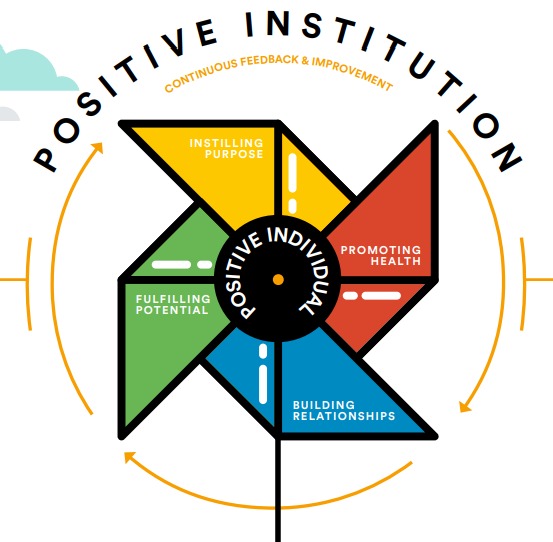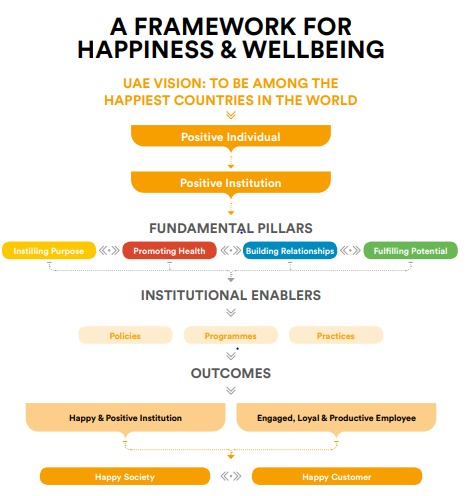UAE National Program for Happiness and Wellbeing at Workplace

Inspired by the vision of the UAE’s leadership and their commitment to making our nation one of the happiest in the world, The National Program for Happiness and Wellbeing launched a guide that helps both government, non-profit and private organizations promote happiness and wellbeing at their workplace.
The sad reality is that 85% of the UAE Workforce is disengaged. This means that of the 6.4M workers, 5.4M are unhappy at work. Nearly 60% of working professionals are looking to leave their job, making staff retention and employee engagement significant areas of focus for the coming years. With limited budget and bandwidth, HR managers (public & private) need to find efficient and effective ways to ensure that every member of their workforce is highly engaged, motivated, and productive.
In this blog we have summarized the National Program for Happiness and Wellbeing guide for you to discover the conditions necessary for employees to thrive and flourish at work in terms of productivity and engagement.
Defining Happiness and Wellbeing
Happiness is defined by two aspects of wellbeing. The first is experiential which refers to one’s emotional state in the moment, and the experience of positive emotions such as joy, excitement, love, hope and amusement. In this sense happiness is when positive emotions are more abundant than negative ones though the latter need not necessarily be absent. The second aspect is evaluative in which individuals reflect on past feelings of happiness and how they contribute to overall satisfaction.
Wellbeing is related to happiness but is still a distinct concept. In addition to considering experiential happiness, it accounts for how people evaluate their lives as a whole, the degree of control they have over them and from where they derive their sense of purpose. Wellbeing is concerned not just with how people feel but also how they function both personally and socially.
Why Happiness & Wellbeing are critical in the workplace
Every single person in our workplace is an asset with the potential to achieve greatness if they are given the right tools and support. Each one of them offers a unique perspective based on their life experience and background. They have the ability to make a positive impact through their work and by setting the stage, we can generate the desire and motivation for them to fulfil that promise. In order to ensure that we are effectively serving our society, we must first look after those who work diligently every.
Happy and positive work environments have numerous advantages over traditional workplaces. Organizations that actively work to create welcoming spaces reap benefits in multiple folds. Some of these are tangible, such as increased retention and improved productivity and quality of work. Organizations also see a steep reduction in absenteeism, sick leave and tardiness. A study conducted at the University of Warwick predicted that productivity levels increased by up to 12% when leadership invested sincerely in promoting happiness and wellbeing at work.
Perhaps the more relevant benefits are the intangible ones. While we cannot directly measure these outcomes, we can feel their impact nonetheless and perhaps more keenly and directly than we feel the effect of objective metrics like productivity. An emphasis on happiness and wellbeing raises morale across an organization, boosts engagement at work and builds trust and loyalty among colleagues and the institution itself.
A Framework for Happiness & Wellbeing
We encourage leaders to use this framework to build a positive culture within their organization that will boost the happiness and wellbeing of their team members

FUNDAMENTAL PILLARS
INSTILLING PURPOSE by ensuring that each organization has a clearly defined vision and set of values which are communicated to employees so they may align their own ambitions with those of the institution.
PROMOTING HEALTH by looking after both the body and the mind and creating a culture in which everyone can grow intellectually, physically and emotionally.
BUILDING RELATIONSHIPS by encouraging team spirit and unity among colleagues as well as building trust and loyalty between employees and the institution, so that people feel like they can reach outside their comfort zones to establish real connections and embrace diversity and inclusion.
FULFILLING POTENTIAL by empowering employees to advance their careers, build their skills, continue to prosper and be recognized for their achievements at work
PART 1: Instilling Purpose at Work
Crafting A Compelling Vision
To craft a compelling vision, leaders can:
Integrate: The organization’s vision into their team’s daily routines with relevant activities and behaviours.
Communicate: The vision in a simple and concise way so it is meaningful and easy to understand.
Keep: The vision relevant so that people are encouraged to align their personal ambitions with its goals.
Embedding a Set of Core Values
To embed a set of core values into the Workplace, leaders can:
Draw: On the ethics and cultural heritage of the nation to inform the institution’s values.
Communicate: Actionable steps employees can take to apply the values in their own work.
Highlight: The impact of the values both internally and externally to reinforce their importance.
Recognize: Employees who best exemplify the organization’s values.
Weaving a Powerful Narrative
To Weave together a compelling narrative, leaders can:
Build: On the vision, values and history of their institution to tell a coherent story.
Reflect: The institution’s narrative in all internal and external communication materials.
Leverage: The history of the nation and tell its story to highlight the higher purpose of government work.
Inspiring a Culture of Altruism
To inspire a culture of Altruism throughout their institution, leaders can:
Implement:CSR initiatives such as volunteering activities that lead to higher engagement and satisfaction among team members.
Highlight: The importance of giving back and how it impacts everyone as individuals and as an organization.
Recognize: Those who go the extra mile to contribute to their communities either through the institution or of their own initiative.
5 Key Steps for Instilling purpose at work
Articulate a clear, concise and meaningful vision.
Link personal contributions and motivation to the organization’s and nation’s goals.
Lead by example by exhibiting the values of the institution on a daily basis.
Embrace an altruistic culture to promote engagement and empathy.
Combine the vision, values and history of the institution into a coherent narrative.
PART 2: Promoting the Health of our People
Integrating the Practice of Mindfulness
To integrate the practice of mindfulness, leaders can:
Encourage:People to take a break, walk, stretch or do breathing exercises to gather their thoughts and be more aware of their current feelings.
Implement: Wellness programs, training or weekly exercises to reflect their commitment to mindfulness and its benefits.
Lead: By example through participation in mindfulness activities and communicating their benefits and availability.
Nurturing a Positive Environment
To nurture a positive work environment, leaders can:
Encourage:People to take a break, walk, stretch or do breathing exercises to gather their thoughts and be more aware of their current feelings.
Create: Spaces in which people are comfortable expressing uncertainty or unusual and innovative ideas, whether in person or online.
Transform: The workspace into a ‘happy place’ by ensuring there is enough natural light and adding plants, colour and entertainment zones.
Consider: How to reorientate the design of the workplace to facilitate greater collaboration and connections between people, while ensuring comfort and safety.
Managing & Regulating Emotions
To help people regulate their emotions, leaders can:
Provide: Resources for people to learn about emotion regulation and raise awareness about its importance.
Create: Spaces in which people are comfortable expressing uncertainty or unusual and innovative ideas, whether in person or online.
Remain: Sensitive to people’s emotional needs and provide the appropriate channels for them to express themselves.
Offer: Tools and programs that can help people regulate their emotions.
Striking a Proper Work-Life Balance
To ensure employees strike a healthy work-life balance, leaders can:
Engage: Employees to understand their needs and consider their opinions when drafting policies that will affect them.
Establish: Programs and policies for paternal leave and overtime hours
Provide: Fitness and/or entertainment initiatives and activities outside of the workplace
5 Key Steps For promoting the wellbeing of our people
Motivate people to take care of their emotional and physical wellbeing
Create an innovative and open-minded culture that promotes creativity
Be mindful of your environment and the circumstances of your employees
Tailor the workspace to embrace positivity and ensure safety
Support people’s pursuit of a healthy work-life balance
PART 3: Building Meaningful Relationships
Fostering a Positive Team Spirit
Exemplify:Collaborative and positive behavior by encouraging others and asking for feedback on their own management ability.
Introduce: Tools such as ‘StrengthsFinder’ to identify and build their teams strengths while ascertaining how best to leverage them.
Display: Optimism, a positive attitude and the values of respect, integrity, and honesty to model exemplary behavior for their employees.
Forming Compassionate Connections
To help their people form compassionate connections, leaders can:
Organize: Activities and team building exercises to bond with colleagues outside the workplace
Be Role Models: By exhibiting the behaviors of a compassionate leader that engages people and cherishes strong bonds.
Facilitate: Connections between team members especially when integrating new people
Embracing Diversity and Inclusion
To embrace diversity and inclusion within their institution, leaders can:
Leverage: The different backgrounds, skills, cultures, and traditions that people bring to build an innovative and knowledgeable workforce.
Integrate: Inclusive policies and practices for all employees which helps nurture a work environment where no one is excluded, marginalized or prevented from accessing certain resources or benefits.
Appoint: An individual or team responsible for diversity and inclusion in the workplace.
5 key Tips for building a Meaningful Relationships
Promote a collaborative, positive, engaged and productive team spirit.
Provide opportunities for colleagues to relate to each other and form genuine connections.
Set a positive tone from the top that inspires a happy and positive work culture.
Build trust within teams to facilitate the open and honest exchange of opinions and ideas.
Strengthen the core of the organization by embracing diversity and inclusion.
PART 4: Fulfilling Potential
Encouraging Accomplishments & Recognition
To Push Their Employees Towards Higher Achievement, leaders can:
Recognise: Work that leads to milestones and accomplishments.
Showcase: Appreciation for the employees’ efforts even if it does not result in an accomplishment.
Supporting Personal & Professional Development
To support the personal and professional development of their people, leaders can:
Provide: Tools and opportunities whether they are theoretical or practical to ensure employees are continuously learning.
Establish: A clear ladder for career development and provide guidance on how individuals can advance from one stage to the next.
Championing Empowerment
To empower the people within their institution, leaders can:
Communicate: Transparently through effective and regular channels that run both ways.
Listen: Carefully to people and empower them to voice their opinions and ideas.
Conduct: Regular exercises to receive feedback on how they can improve the employee experience, such as focus groups, surveys and ‘town halls’ (meetings where a leadership meets with its people to discuss important issues).
5 key Tips for Fulfilling our Potential
Recognize and appreciate contributions, accomplishments and efforts.
Invest in employee development through constructive feedback and learning opportunities.
Empower people to take initiative and take on responsibility.
Outline a clear path for advancement within the institution.
Communicate regularly with employees about institutional development.

This is just a summary of the many initiatives and guides which have been shared by the National Program for Happiness and Wellbeing, for the full guide you can read more here.
How Workfam is inline with the National Program for Happiness and Wellbeing
Instill Purpose
Workfam embraces an altruistic culture to promote engagement and empathy. Through our platform, HR managers can easily recognize the employees who best exemplify the organization’s values, go the extra mile to contribute and who participate in company-wide activities.
Promote Health
Workfam motivates your employees to take care of their mental and physical wellbeing by supporting their pursuit of a healthy work-life balance. We help organizations implement wellness programs and provide fitness initiatives and activities outside of the workplace. Workfam motivates your employees to take care of their mental and physical wellbeing by supporting their pursuit of a healthy work-life balance. We help organizations implement wellness programs and provide fitness initiatives and activities outside of the workplace.
Build Relationships
Workfam provides opportunities for your employees to relate to each other and form genuine connections. Through our platform, employees and managers can organize activities and team-building exercises to bond with colleagues in other departments.
Fulfill Potential
Workfam provides the tools and opportunities to ensure employees are continuously learning. Conduct surveys to improve the employee experience, recognize accomplishments and appreciate the day-to-day work to retain high levels of employee engagement.
Reference: Hw.gov.ae. 2021. [online] Available at: https://www.hw.gov.ae/en/download/a-guide-to-happiness-and-wellbeing-program-in-the-workplace-1

